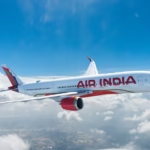In the three-plus years since the Tata Group acquired Air India, the airline has announced a variety of improvements, from ordering hundreds of new planes to unveiling a new logo. But after decades of poor performance, it’s going to take time to persuade Indians and the Indian diaspora to travel on the country’s flagship carrier – as I learned in connection with a recent trip to India.
Air India has a storied – if checkered – history. Founded in 1932 by a member of the Tata family, its first flights carried mail between Karachi and what was then Bombay and Madras. By 1948, it was flying to London and other long-distance locations, including Paris. Its distinctive advertisements often featured a mustachioed Maharaja engaged in (sometimes mischievous) activities associated with one of the airline’s destinations.
But decades of partial and total government ownership, which began in 1953, and the meddling that comes with that, didn’t help. The airline was “a poster child for everything that was wrong with state-owned enterprises,” writes Vasuki Shastry, an author and consultant.
Indeed, it was often plagued by financial mismanagement, poor plane maintenance, questionable customer service, and unpleasant in-flight experiences. A 2011 article catalogued the tales of woe, under a brutal headline: “Air India is Now the Worst Airline Ever.”
While there have been improvements since then, the media still pounces whenever there’s bad news to report. In one infamous 2019 incident, a domestic flight was delayed 12 hours after a rat was found onboard. In 2022, a passenger was stung by a scorpion while in her seat. More recently, a video went viral of water leaking through overhead bins and onto passengers.
Thus while diversity of opinion is prized in India – “two Indians, three opinions,” goes the old saw – my anecdotal experience suggests there’s widespread agreement on one topic: don’t fly Air India.
I discovered this after booking Air India flights between the U.S. and India. I chose the airline because it offered non-stop flights to my destinations and the arrival and departure times were quite civilized (a sharp contrast to what’s offered by foreign carriers). The fares were also reasonable, and I hoped the airline’s Star Alliance membership might get me some benefit with United Airlines, my frequently flown (but far from beloved) carrier, which is also a Star Alliance member.
I’ll confess that I might have also been drawn to the aviation equivalent of eating forbidden fruit. When I told friends and acquaintances about my upcoming trip on Air India, the looks on their faces spanned from amazement to horror. Some reacted like I had committed a faux pas on par with public flatulence. “Oh!” one Mumbaikar said, with eyebrows raised, as if embarrassed about the reveal of such an indiscretion.
A long-time Bangalore resident now living in the U.S. texted me, “you, my friend, are nuts.” And one Indian-American friend looked at me with resignation and simply said, “good luck,” in a way that suggested we might never see each other again.
Several shared their stories, or those of family members, to explain why they don’t fly Air India. They all revolved around shoddy customer service, substandard planes, and extremely tardy departures and arrivals. But one story stood out: A woman recounted a flight she took about 20 years ago to Delhi. It was rerouted, mid-flight, apparently because a VIP on board needed to get to Bangalore. “I haven’t flown them since,” she told me, defiantly.
There were other amusing developments in the weeks before departure. I called my credit card’s customer service line to let them know I would be traveling in India. The agent, who spoke Indian-accented English, remarked that my purchase of Air India tickets had triggered foreign currency fees. Without my asking, she waived the fees. Was this a show of gratitude to someone with a Caucasian name daring to fly Air India? Or did she feel sorry for me?
I also discovered that the airline’s customer service still has some kinks to work out. I initially made a few attempts to reach a live agent through the main reservations number, with a booking question, but failed to reach one. Both times, the virtual agent said a booking link would be sent to the phone number I provided, but the link never arrived.
I did manage to reach someone in one of Air India’s U.S. ticket offices to inquire about the possibility of an upgrade, using my United miles. This set off an amusing sequence of calls, emails, and texts. As one call dragged on and I had to leave for a meeting, the agent said he would call me back. I didn’t believe him – no U.S. airline would ever call you back – but the agent did call back.
When we reconnected, he said he could only explore the possibility of an upgrade if I would provide my United account number, password, and other information he needed to see my mileage balance. For reasons I can’t explain, I gave it all to him – including the answer to a security question that asked for my least favorite childhood food. (Brussels sprouts!)
The agent ultimately said I couldn’t upgrade using miles, but that I could by paying what struck me as a steep premium. “That’s beyond my budget,” I told him. He put me on hold for a minute and when he returned he said he could reduce the price by $1,000. I still declined but thanked him for his persistence – and chuckled to myself about the dynamic pricing.
Suffice to say, I had some trepidation in the days before my flight. But I’m happy to report that these hiccups aside, my Air India experience was lovely. While the queue for boarding was a tad bit more chaotic than what you get with U.S.-based airlines, once ensconced in my seat I had no complaints. I paid a very reasonable fee to sit in the premium economy section, which gave me the legroom I needed (I’m 6’3”). The plane was modern (a 777-200 acquired from Delta) the food was tasty (I had paneer patiala), and the customer service was far beyond what I’m accustomed to on United.
There were also numerous entertainment options to keep me occupied during the 14-hour journey from JFK to BOM. I figured this was the perfect opportunity to watch DDLJ, which I did – cherishing nearly all 189 minutes. On my return from BOM to SFO, I watched a film that I suspect won’t be found on any other airline – a documentary about the India-born Nobel laureate economist Amartya Sen. When that concluded, I asked a flight attendant for guidance on a movie as iconic as DDLJ. Before I could say “Amitabh Bachchan,” I was watching “Sholay.” (And yes, both flights departed and arrived on time.)
Alas, when I relayed these positive experiences to my Indian and Indian-American friends and acquaintances, they weren’t persuaded. One of them, who spent seven years as a flight attendant with Air India, replied, “Well, things couldn’t get much worse.” And some hinted that Caucasians get better service than Desis.
Air India’s new-ish slogan – “window of possibilities” – speaks to the airline’s ambition and potential. But it clearly has work to do with its biggest potential customer base. While my experience suggests Air India is (mostly) on the right path, the real test will be the experiences of Indians and the Indian diaspora. If they praise the airline to family and friends, the brand will benefit from the most powerful messaging medium of all – word of mouth. But if more rats or scorpions are found onboard? That “window of possibilities” will be sealed shut.
Disclaimer: The opinions and views expressed in this article/column are those of the author(s) and do not necessarily reflect the views or positions of South Asian Herald.





